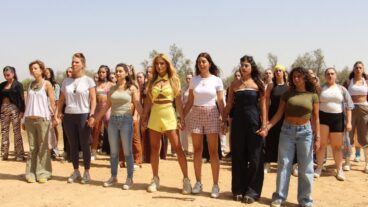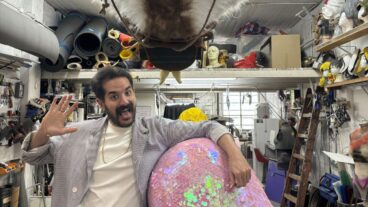No matter where you look on the cultural landscape, Israeli musicians, filmmakers, actors and dancers and artists have been shaking up the international scene in growing numbers over the last five years.
Whether it is four indie rockers who appeared last week at New York’s premier music industry conference, the CMJ Marathon, or films and authors regularly receiving rave reviews in American media, the proliferation of Israeli culture throughout North America, has succeeded in exposing an overlooked side of Israel and its people.
In the music field, three trends have brought Israeli musicians to the global conscience. As exemplified by the CMJ performances of Anat Damon, Rockfour, Katamine and Ex-Lion Tamer, more Hebrew-speaking singers now prefer to sing in English.
“There’s a great music scene in Israel and great art and people should know that,” says Elran Dekel of the English-language groove-funk band Funk’n’stein.
English-language musicians are not the only ones burning up the international music landscape. Israel is also known the world over in a niche that is less dependent on language – electronic music.
“Israel is leading when it comes to electronic music on the global scene. We have some of the top DJs and MCs in the electronic field,” Ronit Arbel, a public relations consultant for top artists in Israel, told ISRAEL21c. “Israeli electronic stars like Henree, Ivri Lider, and DJ Yahel have much to offer the global community.”
Lider is currently on a cross-country tour of the US, following a successful visit last year.
World music is another trend that has taken off over the years. Stars like Idan Raichel (who has performed at the Apollo Theater in New York City), Mosh Ben Ari, and Sheva – who sing in Hebrew, Amharic and Arabic – all fill venues abroad.
“If it’s good, it doesn’t make a difference what language music is sung in,” Arkadi Duchin, one of Israel’s top rock musicians, told ISRAEL21c. “I listen to a lot of music that I don’t understand. Hebrew lyrics shouldn’t stop anyone from listening to Israeli music. We have excellent musicians here and the output is top-notch.”
And of course the country’s contributions in classical music and jazz, already with a well-established international reputation, continue to grow. From the young conductor Yaron Gottfried to maestro Dan Ettinger to composer/pianist Gil Shohat to violin virtuoso Itzhak Perlman, audiences and critics across the board continue to revel in Israeli classical music productivity.
Meanwhile, the impact Israeli musicians have on the New York jazz scene is nothing short of remarkable. Double bass player Avishai Cohen, bassist Omer Avital and trombonist Avi Lebovich have all made it big in the epicenter of the jazz world.
Other Israelis making waves include former Herbie Hancock band member saxophonist Eli Dejibri, trumpeter Avishai E. Cohen and pianist Anat Fort.
“Israelis have made a huge impact on the New York jazz scene,” says Kim Smith, publicist of New York’s renowned Blue Note jazz club. “They work very hard at their craft and are sometime relentless in the pursuit of music. They are open to everything.”
Israeli cinema has also improved drastically over the last five years. The country’s films continue to pocket prestigious awards at festivals across the globe. 18 Kilos of Love recently won the Media Access Award at the Universal Studios in Los Angeles.
In 2000, the government passed a New Cinema Law that would ensure more funding for domestic films. “That law meant more films were being made and many of them became hits both here and abroad,” Hannah Brown, film critic for The Jerusalem Post, told ISRAEL21c.
Other domestic films to win prizes at international festivals over the last five years include Yossi & Jagger (2002), Broken Wings (2003), Ushpizin (2004), Walk on Water (2004), More Than 1000 Words (2006), among many others.
In a country of just seven million people, there are 10 film schools and seven international film festivals.
“I don’t think there’s anything different about Israeli cinema and that’s what I love about it,” says Brown. “It used to be rare to find an Israeli movie with good acting, good directing, good script and photography… but today the films include all that.”
The country’s theater scene has also broken language barriers over the last few years.
The Clipa multi-disciplinary company is one of the primary representatives of Israeli alternative theater abroad.
The New York Times raved over the Gesher Theater Company’s production of “The Slave” when it featured at the Lincoln Center Festival in 2004. Now, Americans will get the chance to hear Hamlet’s classic “To be or not to be” soliloquy performed in Hebrew at the upcoming Shakespeare in Washington festival in Washington, DC in March 2007. Taking the lead is actor Itay Tiran who recently won an America-Israel Cultural Foundation scholarship.
“Theater is about sharing an experience,” Omri Nitzan, artistic director of the Cameri said last year. “Through theater you can recognize and meet the society that it’s born in, the temperament, the themes, the energy, the view, how things are looked at politically, humanly.”
Israeli dance has also sophisticated over the last five years and continues to show its prowess. While for many years it was only Ohad Naharin’s name that came up in conversation when talking about Israel’s dance scene, many other names are now included on the list.
Choreographer Emanuel Gat wowed the American Dance Festival last year. Gat also performed at this past summer’s Lincoln Center Festival, as did choreographer Yasmeen Godder, and the acclaimed Batsheva Dance Company.
“It’s hard to say [where they rank in the world] because Israel is such a small county, but per capita, it has got to be number one,” said John Rockwell, chief dance critic of the New York Times.
“Israeli modern dance is now a well-known brand around the world,” critic Rakefet Keidar told The Jewish Week. “They are at the forefront of innovation, they connect and draw from very real materials and life experiences, and this endears them to dance fans who are tired of seeing the same abstractions.”
And in visual arts, Israel continues to shine abroad. Over the past five years there has been an increased awareness of Israeli art internationally.
Video artist Michal Rovner was the first non-American artist to have a show at the prestigious Whitney Museum of American Art in 2002. Photographer Adi Nes exhibited his works at the Jewish Museum, New York and the Museum of Contemporary Art, San Diego; installation artist Gal Weinstein exhibited at Exit Art in New York; and visual artist Yehudit Sasportas recently exhibited at the Robert Tilton Gallery in Los Angles.
This year, the first-ever museum exhibition of contemporary Israeli design in the US took place at Smithsonian’s Cooper Hewitt museum in New York. “There has been a great renaissance in Israeli design in the last five years,” said curator Ezri Tarazi, head of the industrial design graduate program at Bezalel Academy for Art and Design in Jerusalem.
“Israeli contemporary art in particular is getting more recognition in the art world,” Smadar Sheffi, art critic for Ha’aretz newspaper, told ISRAEL21c. “You see it in international exhibitions. The talent is certainly there, and real efforts have been made beginning in the early ’90’s to export Israeli art.”
“Israeli artists have been popping up in Europe and the US like mushrooms after the rain,” Tami Katz-Freiman recently told the Jerusalem Post. “Every good Israeli artist who has exhibited abroad has created a buzz, and I predict that exposure abroad will continue to grow.”
Be it in music, dance, film, theater, or visual arts, Israelis continue to break new ground in the world of culture around the world.
“What I like about Israeli culture is the mix of traditions it comprises from the east, the west, Africa, Europe, Russia, etc. Israel is a melting pot,” says Arbel. “Our culture is different from anywhere else in the world. And all these influences can be found in our music, art, theater, dance and visual arts.”












